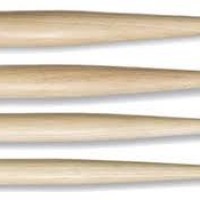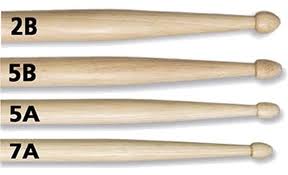
If you have ever been to a drum shop and seen the collection of drumsticks to choose from, you may understand how hard it can be to choose the right sticks for you. It’s true that making this choice can feel daunting if you don’t understand differences between them. In this article you will find a detailed explanation of most drumsticks along with the drumming styles and drums they are most suitable for.
It is important to start with the numbering system that is used to label drumsticks. If you have ever picked up a pair of drumsticks, you probably noticed the numbers and letters by the logos on the butts of the sticks. These numbers and letters are used to classify the size and shape of the drumsticks, in that order.
Examples of these classifications are 2B, 5B, and 7A. The system is simple and works like this. The number symbolizes the size of the stick; the higher the number, the smaller size and vice versa. For example a 7A stick is smaller in circumference, or thinner, than a 2B stick.
The letters used to classify the drumstick go all the way back to the creation of the drumstick. The three original letters were “S,” “B,” and “A,” and were used to label the application of each type of stick. The “S” model sticks were meant for street applications. Marching drums were the main use for “S” model sticks in marching bands and drum corps.
“S” model sticks are typically larger than their “A” and “B” cousins, since they need to be loud and project sound much further. “B” model sticks were designed for band applications, such as brass and symphonic bands. Smaller than “S” model, but larger in size then “A” sticks, these sticks could project in large symphony bands and were ideal for beginning drummers to build muscle strength. To this day, “B” sticks are always a functional recommendation for beginning drum students to develop muscle strength, speed and dexterity.
“A” model drumsticks are meant for Orchestra. At the time big band and dance orchestras were very popular, thus the smaller drumstick became prominent for softer and/or faster playing. Today “A” sticks are still very popular for most jazz and rock players. “A” sticks tend to break much sooner than “B” or “S” sticks, so for styles of music that require a louder sound or a stronger back beat, I would recommend “S” or “B” sticks. Today, there are many more letters to choose from, but “A,” “B,” and “S” drumsticks remain the most popular classification method for choosing drumsticks.
 Next, you should know the different parts of the drumstick so you can understand how the sound changes on the drums or cymbals as they are played. I have already referred to the butt of the stick in this article; the butt is the bottom of the drumstick and provides counterweight.
Next, you should know the different parts of the drumstick so you can understand how the sound changes on the drums or cymbals as they are played. I have already referred to the butt of the stick in this article; the butt is the bottom of the drumstick and provides counterweight.
The long middle part of the stick is called the shaft. The shoulder, or the area near the tip where the circumference gets narrower, is called the taper. And the tip is the bead at the end of the drumstick. The four parts of the drumstick can all be used to make different sounds on drums and cymbals.
The butt can be used for extra volume and power, but you may also notice your speed and dexterity take a slight drop. Simply turn the stick around, holding the stick where is tapers, and strike with the butt. The shoulder of the stick is used often for rim shots on drums and cymbal crashes and swells on cymbals.
Sticks will in come in different taper lengths too, short ones being more durable and will sound stiffer, while long ones will be more fragile and have a delicate sound. The shaft of the stick is typically used if you are playing on the rims of the drums. This part of the stick is the thickest and most durable, so it can hold up to the beating it will take on the rims.
Tips come in different shapes that will influence the sound the drumstick produces tremendously. The first choice for drumstick tip is between wood and nylon. Drummers choose wood tips for their natural warm and full tones, while nylon tips are more durable with a much brighter tone.
There are four basic shapes to choice from in wood or nylon. Round tips come in a range of sizes and work especially well on cymbals. Small round tips will provide short high pitched pings while larger round tips will give a much more full sound. Barrel tips have a larger surface area that strikes the surface to provide a more diffuse tone than round tips.
Pointed tips will provide a medium tone since the angle of the tips lands flush with the surface of the drum or cymbal to produce a greater tone. The last tip is the teardrop tip and will provide an array of different sounds depending on how the stick is held and applied to the surface.
More than the classification of drumsticks and the anatomy of the stick are the types of woods used to create them. The three main types of wood used are maple, hickory and oak. Maple sticks are the lightest available allowing you to play much faster, but will produce a lower volume.
Hickory sticks are the most popular since they are more durable and louder. Hickory sticks also absorb more shock, causing less stress on your wrists. Oak sticks are the heaviest of the three types of woods, which lend them to a much louder volume and are extremely durable. Often drummers will practice with oak sticks to increase their speed and dexterity, so that when they perform with lighter sticks they will be much faster and stronger.
Selecting the type of drumsticks for your scenario should now make much more sense. Thicker, heavier sticks are ideal for rock and R&B styles for the strong back beat it usually requires. Lighter sticks are wonderful for softer styles of music like folk and jazz where finesse is the key. Also, it is always recommended to practice drumming with sticks that are normally heavier than the sticks you will perform with, exercising your muscle strength and speed.
More than anything else, drumstick selection is a completely personal choice. Test out as many options as you can to determine which drumsticks will work best for the drumming scenarios you are involved with.
Thanks.
Chris
Leave A Reply (11 comments so far)
Verne
Good Info Regarding Stick choices. You may want to add that laquer coated sticks offer less slippage. Slippage equates to sooner fatigue, and more chances of dropping a stick.
My favorite is Regal tip Jazz stick. No letter or number code. It’s basically 7A but 3/4 of an inch longer.
Chris
Great info Verne! Do you use the same sticks for every gig and style you play?
Tommy "Kip" Davenport
Chris,
Excellent advice on drumsticks. I have found the older I get the lighter I like my sticks. No just kidding. I do prefer 7A (hickory), but over the years I have used some of every type of sticks even rock knockers. I like sticks that are longer as Verne noted. Extra length is extra reach which comes in good when you are playing a large drum kit. As the saying goes experience is the best teacher. I would like some advice on tuning drums. I know the sound I want, but sometimes it is difficult to get. I play a lot of heavy metal rock so I like to tune more to that sound. But, again variety is the spice of life. It is good to be well versed in all music. I took lessons from a college jazz major when I was 7 years old. He said and I learned to believe that “if you can play jazz you can play anything”. Rythm and blues is the Grandfather of Rock and Roll. It is all good.
Thank you again,
Kip
Chris
Great thoughts Kip! You are right, the best teacher in most cases is experience. Sticks vary in a hundred different ways and the only way to know what works for you it to try a few different kinds. I play a couple of different varieties depending on what kind of gig I am doing. I generally like the longer pairs of drumsticks as well.
As far as tuning goes, I have a whole section in the “Play Drums By Ear” course I think you will find very helpful. In general rock, punk, or heavy funk drummers stick with thicker 2-ply heads for their top tom heads and single ply on the bottom. If you are playing a lot of big open notes then I would tune them to a lower pitch to let them “sing” a bit more and feel like cannons. If you are playing a lot of fast notes like a modern fusion/funk drummer, they tend to tune up a bit and implement a little more muffling to create a tighter sound with less sustain.
Hope this helps and I will talk to you soon!
Sandy Smith
Thanks for this article! As a total beginner buying sticks, I had no idea what the numbers and letters even meant. Now I do, I appreciate your site and info!
Chris
You got it Sandy! Glad it is helping you hit the ground running.
Mark
Nice work, thanks man.
I play rock and only used 5A whatever but now I am going to try hickory for the shock absorbtion and barrel tips for the resonation of the cymbals.
Keep ’em comin’
Saul
On second thought I decided to read your article ( I some times I think I know it all it’s part of my missinformed ego). I’m glad I did, I learned a few things. Thanks Saul
Lenny
Chris, that was awesome. I never knew any of of that. My favorite sticks are the A’s, and I’ve been playing for about 25 years, and all by ear. Thanks.
Chris
@Lenny: I know the feeling! I have been playing for about the same amount of time and I still feel like I learn something new all the time! I love when that happens
mike
great article chris.